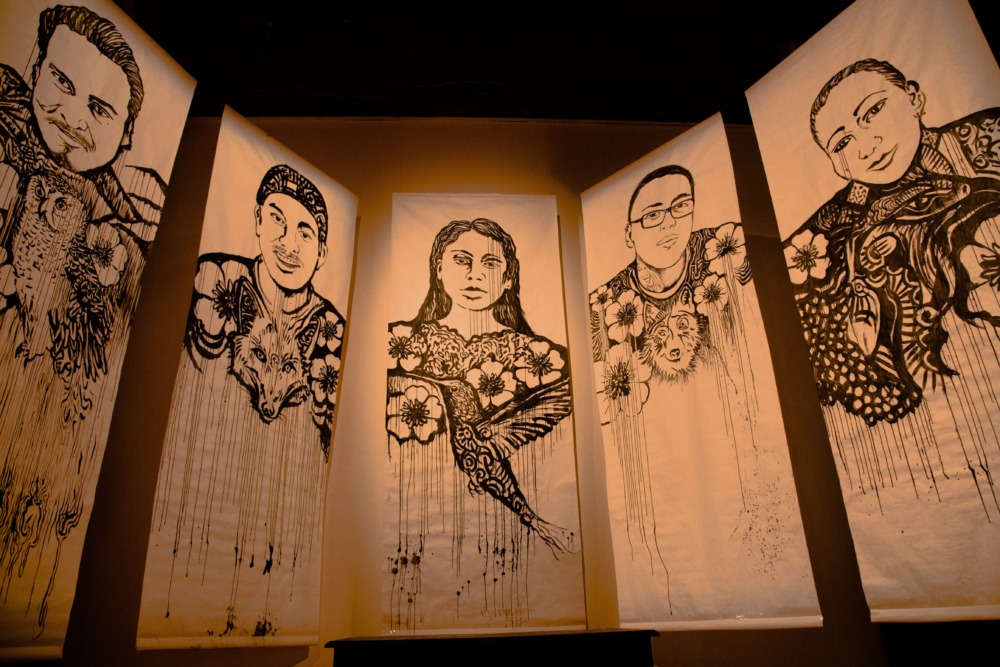SF Bay Area Residents Honor Ancestors Through Art
By Johanna Ochoa
jochoa32@mail.ccsf.edu
Honoring ancestors, artists, and beloved ones, SOMArts presents its 22nd Día de Los Muertos exhibition, with 17 pieces of art including traditional altars and contemporary installations.
“Dreams Emerging, Beyond Resilience: Día de Los Muertos 2021”, is the name of this year’s exhibition that was created for 19 Bay Area artists and collectives.

“The outcome is an exhibition that gives reminders of the ways we’re connected and in dialogue with our ancestors. It also asserts that we are each other’s greatest strength and we can do more than just be resilient, we can imagine and create new realities in which we can thrive,” said Carolina Quintanilla, co-curator in this exhibition.

Oct. 9. Photo by Janna Velasquez/The Guardsman.

The BAAITS Drum. Oct. 9. Photo by Janna Velasquez/The Guardsman
17 pieces including contemporary installations, traditional altars, and a video accompany this exhibition that shows the visions of different artists presenting altars.
“What’s unique about this show is the perspective of it. It’s looking at our ancestors, at the people who have been so monumental to us that we want to honor, taking their knowledge, taking their lessons and their lived experiences, and using that to move forward with the world that we want to see,” expressed the artist Rio Yañez.
Quintanilla has co-curated the show with Rio Yañez since 2018, she began working with Rene Yañez on the SOMArts Día de los Muertos exhibition in 2016. René, father of Rio, was one of the visionaries who introduced the San Francisco community to the Day of the Dead festivity as an art practice. Now, Rio continues with his father’s legacy.
“My father was one of the first to establish the celebration as an art exhibit in the Bay Area. In the ’70s, as part of the collective of ‘Galería de la Raza’, he was able to present altars as works of art. And from there in the ’80s and ’90s, he began to experiment creating physical spaces for the altars like individual rooms,” said Yañez.
One of René’s biggest contributions was opening opportunities for many artists. “He opened it up to artists of many different backgrounds, you can see what it means when you see artists from a different mix of cultures showing creatively what it means for them to honor the dead; I think that was truly like my dad’s gift, to really embrace other cultures, other ideas and ways of what it means honoring the dead. It’s something that’s really important to me, to continue as part of his legacy,” Yañez said.

Guardsman
Quintanilla mentions that the exhibition has evolved in different ways over the years. “In the last couple of years, the pandemic was a catalyst for a different scale of artwork. With safety at the top of mind, we worked with a fewer number of artists and it was fun to see how artists took it as a challenge to experiment. Both years, the exhibition included artists who created bigger installations than they ever have before and many took on new mediums.”
The Día de Los Muertos exhibition is one of the most internationally diverse Day of the Dead celebrations in the United States.

“Día de Muertos for me is a big cultural and creative practice. It’s definitely a way to connect to my roots very consciously engaging as a Chicano and Mexican American. And I think it’s a chance to celebrate the lives of those who have passed away to honor them to reconnect with them, through offerings, and any creatively, for me it’s definitely an outlet, as someone who has lost both of his parents in the last couple of years, it’s way too I think, do a lot of healing and a lot of reconnecting to them in a way that’s very personal,” Yañez expressed.
This year’s exhibit honors artists who recently died, including Elizabeth ‘Betita’ Martínez, Moira Roth, Betty Segal, and Ronnie Goodman, as well as Yolanda López, Rio’s mother, who unfortunately passed away around a month ago.

The Guardsman
“My partner and I created the altar to my mother that’s part of the exhibition. It was incredibly very healing to put it together and to kind of present it both as something very personal to my family, but also as a work of art that honors someone. It’s an anchor to the show, very contemporary but traditional Mexican culture,” Yañez said.
The exhibit is open to the general public and will be on display at SOMArts until November 5.
